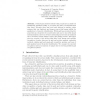Free Online Productivity Tools
i2Speak
i2Symbol
i2OCR
iTex2Img
iWeb2Print
iWeb2Shot
i2Type
iPdf2Split
iPdf2Merge
i2Bopomofo
i2Arabic
i2Style
i2Image
i2PDF
iLatex2Rtf
Sci2ools
AC
2003
Springer
2003
Springer
Biometric Gait Recognition
Psychological studies indicate that people have a small but statistically significant ability to recognize the gaits of individuals that they know. Recently, there has been much interest in machine vision systems that can duplicate and improve upon this human ability for application to biometric identification. While gait has several attractive properties as a biometric (it is unobtrusive and can be done with simple instrumentation), there are several confounding factors such as variations due to footwear, terrain, fatigue, injury, and passage of time. This paper gives an overview of the factors that affect both human and machine recognition of gaits, data used in gait and motion analysis, evaluation methods, existing gait and quasi gait recognition systems, and uses of gait analysis beyond biometric identification. We compare the reported recognition rates as a function of sample size for several published gait recognition systems.
| Added | 06 Jul 2010 |
| Updated | 06 Jul 2010 |
| Type | Conference |
| Year | 2003 |
| Where | AC |
| Authors | Jeffrey E. Boyd, James J. Little |
Comments (0)

